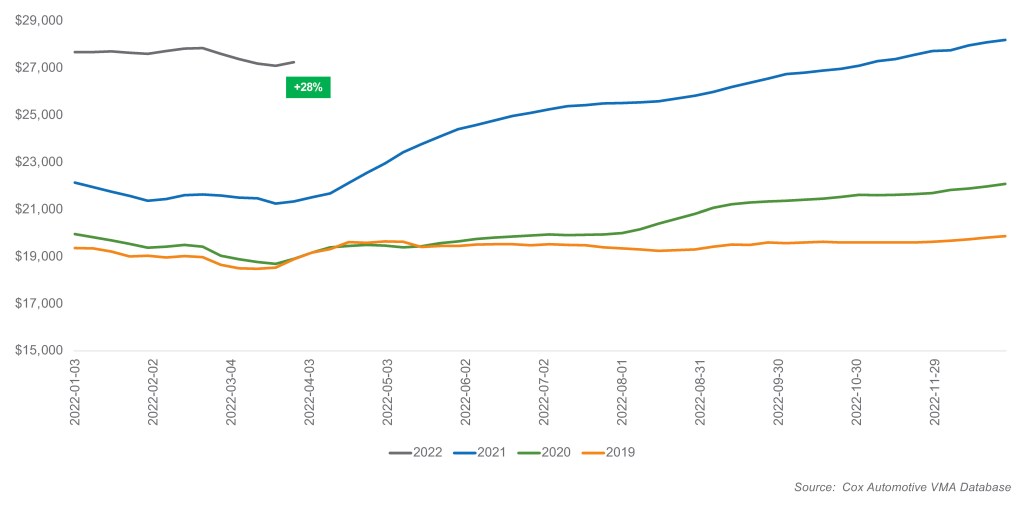Data Point
Weak Spring Sales Buoy Used-Vehicle Supply
Thursday April 14, 2022
Article Highlights
- The delay in issuing tax refunds has caused the traditional spring sales bounce to be weak so far and likely postponed to April.
- Used-vehicle supply was lower at the end of March than in February but is higher than a year ago.
- The average used-vehicle list price remained high but edged down from February to $27,246.
Revised May 19, 2022 – The disappointing spring bounce for used-vehicle sales has led to higher inventories than a year ago, though supply edged downward through the month of March, according to the Cox Automotive analysis of vAuto Available Inventory data.
2.53M
Total Unsold
Used Vehicles
as of March 28
42
Days’ Supply
$27,475
Average Listing Price
69,093
Average Mileage
At the start of April, the total supply of unsold used vehicles on dealer lots across the U.S. stood at 2.54 million units. That compared with Cox Automotive’s revised number of 2.62 million at the end of February. Inventory opened April nearly 5% above year-ago levels.
Days’ supply at the end of March stood at 45 compared with a revised number of 54 at the end of February. But March days’ supply was up from 32 at the same time a year ago. Used-vehicle supply had been building up in the early months of the year until mid-February, the normal start of the tax refund season. That supply has been edging downward ever since and remains ahead of a year ago.
The Cox Automotive days’ supply is based on the daily sales rate for the most recent 30-day period, in this case, ended March 28.
Retail sales of used vehicles have been disappointing. They are estimated to have increased 37% from February to March but failed to show the typically even larger seasonal increase driven by tax refunds. That has pushed sales an estimated 15% below year-ago levels. CPO sales are estimated to be down 19% last month compared with March 2021 but up 21% from February.
The issuance of tax refunds is several weeks behind the normal pace this year. Based on IRS statistics through April 1, an estimated 49% of this year’s likely number of tax refunds had been issued when for the same week in 2019, 77% had been disbursed.
“Used-vehicle sales will likely see a stronger April performance as the refunds continue to flow in combined with the fact that the average refund is at a new record and up 12% from a year ago,” said Jonathan Smoke, Cox Automotive chief economist.
At the end of March, the average listing price was $27,246, off record levels in December when it surpassed $28,000. The list price was down some from the end of February when it was a revised $27,609.
Average Used-Vehicle Listing Price
“Prices remain high, up 28% from a year ago,” noted Charlie Chesbrough, Cox Automotive senior economist. However, he added the growth rate for prices should slow. “The anniversary of the chip shortage – when prices started to skyrocket – is approaching. Year-over-year growth rates will come back to earth. However, prices will not go negative. Rather they should return to more normal growth trends but from a higher base.”
On the wholesale slide, used-vehicle values, according to the Manheim Used Vehicle Value Index, declined 3.3% in March on a seasonally adjusted basis.
The lowest price segment had the lowest inventory and lowest days’ supply, according to Cox Automotive’s analysis of vAuto Available Inventory data. Vehicles under $10,000 had only a 26 days’ supply. Those priced between $10,000 and $20,000 had days’ supply under 37. Price segments from $20,000 to $30,000, had days’ supply ranging under 50. Vehicles priced over $35,000 had a 60 days’ supply.
For more insights on used-vehicle inventory using a 30-day rolling sales methodology to calculate days’ supply, reach out to the Cox Automotive Public Relations team.
Michelle Krebs is executive analyst at Cox Automotive.

